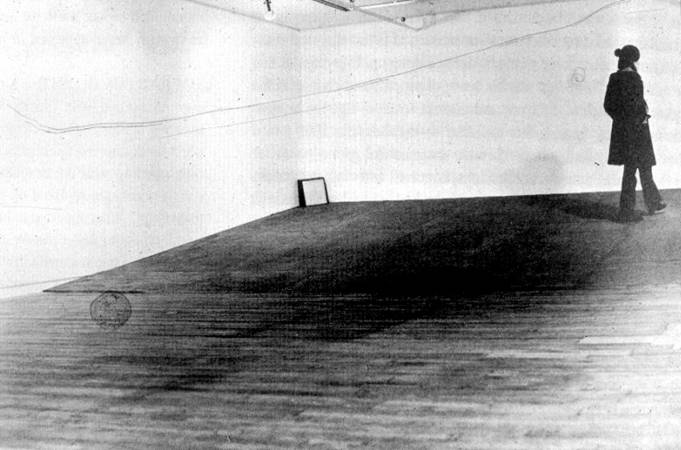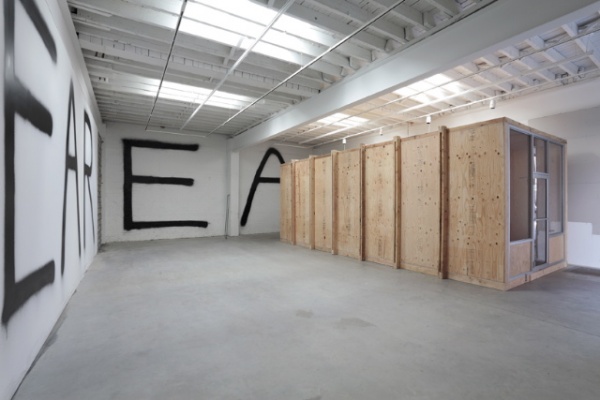Sculpture Studio Spring 2010
/Jamie Spencer-Zavos
Project 2: Kinetics and Interactivity
ARTIST RESEARCH
Both Rirkrit Tiravanija and Vito Acconci are artists who are intimately concerned with the way an audience
interacts with and approaches art. They are both concerned with the power given to the artist. Tiravanija
wants to find ways to explore how sharing that power can influence how an audience approaches his
art. Acconci is concerned with how he can make those power dynamics as clear as possible. Acconci
explicitly claims space for himself and Tiravanija explicitly gives away those spaces beholden to the artist.Acconci began working as a poet. According to an interview in Design Boom magazine, Acconci, “got
his M.F.A. in literature and poetry from the University of Iowa.” (DM) However, Acconci soon became
aware of a personal need to move beyond the confines of the page. As a writer, Acconci was, “obsessed
with questions such as – what makes you move from left margin to right margin? – from top of the page
to bottom of the page?” (DM) Acconci soon realized that he needed to move beyond the page, and
start moving onto the floor and the wall. In other words, Acconci realized that he needed to start making
art. What initially drew Acconci to art, “was that art was a non-field field, a field that had no inherent
characteristics except for its name, except for the fact that it was called art.” (BI) In art, Acconci saw an
opportunity to think in a more expanded way. To this day, Acconci says that reason he makes art is, “for
myself, to prove I can think.” (BI)Much of Vito Acconci’s early work is grounded in the conceptualism of the late 1960s and early 70s. He
began working “after the late sixties, the time-the starting time of gender other than male, race other
than white, culture other than Western.” Indeed as an early performance artist, Acconci was inherently
reckoning with gender roles. In Acconci’s view, “performance in the early seventies was inherently
feminist art.” (BI) In the view of art critic Jerry Saltz, Acconci was more than up to the challenge. “Acconci
was a perfect counterweight to many of the female artists mentioned above, some of whom were as
trailblazing with their bodies as he was with his.” (NY) Acconci often used his body and his sexuality as a
way to claim a space for himself.
In Seedbed, Acconci built a ramp that took the place of the gallery floor, and hid underneath it and masturbated. While masturbating, he described, “sexual fantasies about the people above me.” (IA) Through this action, Acconci claims the gallery space for himself. If the audience member walks up the ramp, they become a part of Acconci’s fantasy, entering his sexual realm. For Acconci, “Place is a kind of battlefield-the notion that taking a place means taking it away from someone else. Space as domain, space as boundary, space as a kind of power.” (VS)
Acconci’s early performance work is inherently interactive. Many of Acconci’s pieces served as
challenges to the audience. Walk over the ramp, if you are willing to become a part of this man’s
fantasies. Another of Acconci’s pieces makes this challenge explicit.
In Claim, Acconci sits at the bottom of a staircase in a chair and blindfold and repeatedly claims the space as his, by muttering phrases such as, “I’m alone here in the basement, I want to stay alone here in the basement, I don’t anybody to come down into the basement with me, I’ll stop anybody from coming down into the basement.” (IA) Acconci is also armed with lead pipes and baseball bats. At the top of the staircase there is a television set that displays a live feed of Acconci at the bottom of the staircase. Acconci is challenging the viewer, demonstrating the power he has an artist to claim a part of the gallery space.
Rirkrit Tiravanija is also very concerned with how the artist can claim a gallery space. Like Acconci,
Rirkrit didn’t come to art immediately. Rirkrit was enrolled at Carleton University, in Ottowa. Initially he
wanted to be a photojournalist, but according to New Yorker profile by Calvin Tomkins, “Two slides
projected on a screen changed everything for him. One slide showed Kazimir Malevich’s ‘White on
White,’ an abstract painting of a white square superimposed on white ground; the second slide showed
Duchamp’s ‘Fountain,’ a porcelain urinal turned upside down and presented as a sculpture.” (NY) With
this dramatic introduction to conceptual art, Rirkrit realized that what he needed to be doing with his
life was making art. What Tiravanija said he would’ve done with Duchamp’s ‘Fountain,’ is a perfect description of his approach to art-making. Tiravanija wants to, “take the urinal and re-install it back on the
wall and piss into it.” (NY)Tiravanija often seeks to de-gallerize the gallery. He seeks to transform the gallery into a democratic
space, to dissolve, “the tenuous boundaries between viewer and participant.” (SM) Tiravanija seeks to
make life into art and art into life and all the way back again. He “sends art (wherever and whenever
that may be) packing, transporting it elsewhere.” (AF) One of Tiravanija’s most famous works in which
he “built a full-scale wooden replica of his East Village apartment in the Gavin Brown Gallery,” (NYM)
is a perfect example of this.
He opens the gallery to the public reducing the power of the artist over the gallery space and democratizing it. However, this freedom Tiravanija grants the audience is not always (as it is often pegged) utopian. According to his long time gallerist, Gavin Brown, “there’s a lot of anger in the work, and a lot of aggression.” (NY) Usually this aggression doesn’t come to the forefront, because often audience are reduced to timidity by the gallery space in which Tiravanija’s work exists. However, at one opening, “a gallerist named Tom Cugliana instead of boiling an egg, picked one up and smashed it against the wall. Several other people did the same thing. Elizabeth Peyton (Tiravanija’s wife at the time) who was there, said later that it was sort of frightening, a look into the dark side of freedom that Rirkrit’s work embodied.” (NY) Tiravanija’s work serves as a sort of mirror of human nature, and at times it exposes the very dark side of human nature. However, it also exposes some of the more beautiful parts of human nature. One of Tiravanija’s more famous pieces was when he set up a drum set and guitars at the Whitney Biennial. Many people were too intimidated by the museum’s oppressive silence to play the instruments. However, “several different bands of young, unknown musicians would meet there by arrangement to practice or to play.” (NY)
Vito Acconci
(IA)
Acconci, Vito. “Some Notes on Illegality in Art.” art journal 50.3 (1991): 69-74. JSTOR. Web. 20 Feb.
2012. <http://www.jstor.org/stable/777220>.(BI)
- - -. “Vito Acconci.” Interview by Richard Prince. BOMB Summer 1991: 52-59. JSTOR. Web. 20 Feb.
2012. <http://www.jstor.org/stable/40425023>.(DM)
- - -. “Vito Acconci.” Design Quarterly 122 (1983): 4-5. JSTOR. Web. 20 Feb. 2012. <http://www.jstor.org/
stable/4091072>.(VS)
- - -. “vito (hannibal) acconci.” designboom 21 May 2006: n. pag. designboom. Web. 20 Feb. 2012. <http:/
/www.designboom.com/eng/interview/acconci.html>.(NY)
Saltz, Jerry. “Vito de Milo.” Village Voice: n. pag. artnet. Web. 20 Feb. 2012. <http://www.artnet.com/
magazine/features/jsaltz/saltz4-28-04.asp>.Rirkrit Tiravanija
(AF)
Hainley, Bruce. “Where are we going? And what are we doing? Rirkrit Tiravanija’s art of living.” Artforum
1996: n. pag. Findarticles. Web. 20 Feb. 2012. <http://findarticles.com/p/articles/mi_m0268/
is_n6_v34/ai_18163691/pg_5/>.(NYM)
Saltz, Jerry. “Conspicuous Consumption.” New York 7 May 2007: n. pag. nymag. Web. 20 Feb. 2012.
<http://nymag.com/arts/art/reviews/31511/>.(SM)
Stafford, Amy. “Rirkrit Tiravanija.” Surface Magazine 1998: n. pag. Blixa6. Web. 20 Feb. 2012. <http://
www.blixa6.com/ci/Tiravanija.html>.(NY)
Tomkins, Calvin. “Shall We Dance?” The New Yorker 17 Oct. 2005: n. pag. PDF file.
Back to Index
This page was last updated:
February 21, 2012 1:51 PM


